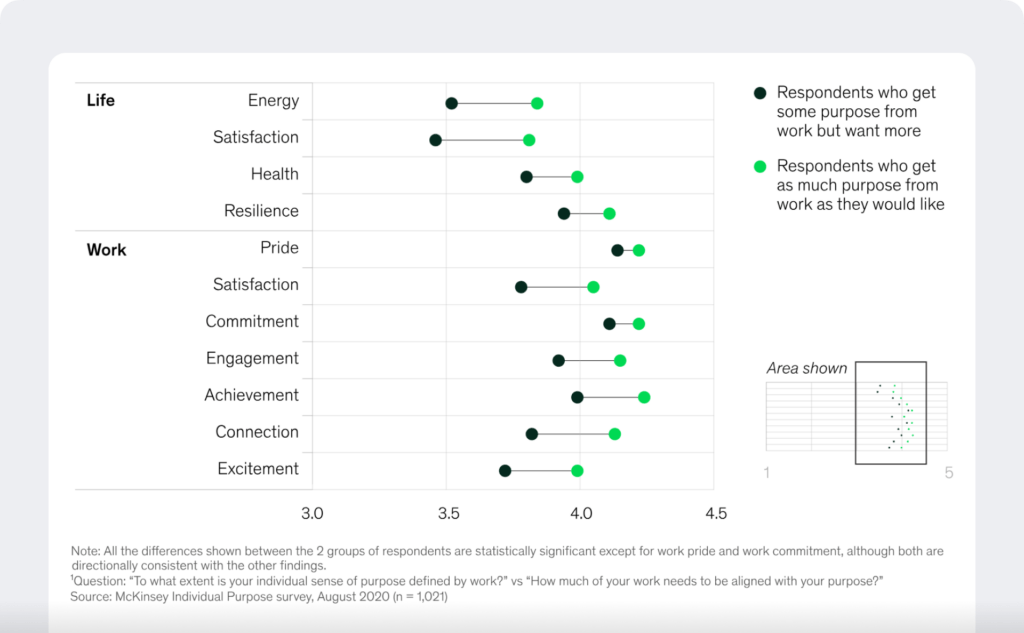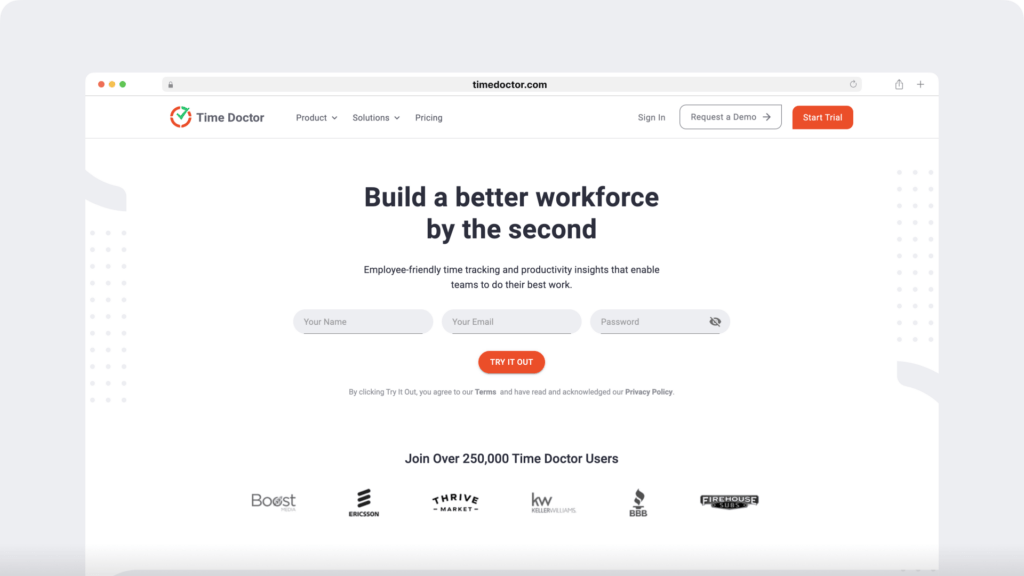“Employee engagement” and “wellbeing” are often used interchangeably. That’s no surprise, seeing as they are so closely linked.
But employee engagement and wellbeing are unique. Reciprocal, cumulative, and connected – but still unique.
Understanding where one ends and the other begins is crucial to integrating these elements to maximize productivity without risking your best people burning out.
Employee engagement and wellbeing: Definitions, differences and interdependencies
Employee engagement is the level of dedication and enthusiasm that a worker feels toward their job.
Wellbeing, on the other hand, is their overall state of physical, mental and emotional health.
(Keep in mind we’re focusing on workplace wellbeing; while career satisfaction almost certainly reflects in personal wellbeing, there are many more factors weighing in).
Employee engagement and wellbeing are highly complementary, for better or worse. People who report feeling engaged at work are more likely to be healthy and happy, while fearful or overworked employees are less motivated and less productive.
This interplay means that leaders can improve one outcome to support the other.
However, evidence suggests that overdoing engagement can tip employees into exhaustion, cynicism and inefficiency.
Gallup’s research into employee engagement and wellbeing in the peri- and post-pandemic years also found that “engaged employees who are struggling or suffering in their overall lives have a 61% higher rate of burnout”.
This is partly because, as McKinsey found, 70% of employees derive their sense of purpose largely from work. Health and happiness scores fall when that purpose is lacking – as it is for 51% of employees and frontline managers.

A balanced approach is best
When Gallup analyzed the differences between engaged and non-engaged employees, using questions that also touched on happiness outcomes, they found stark differences.
Engaged employees exhibited:
- 81% lower absenteeism
- 18-43% lower turnover
- 64% fewer safety incidents
Profitability was also 23% higher, productivity was 18% higher, and customer loyalty was 10% higher in engaged workforces.
All this data backs up what effective leaders are starting to understand through observation.
Addressing employee engagement and wellbeing as separate but integrated contributors to productivity and performance is the way to maximize outcomes in both without tipping the balance.
When engagement and wellbeing are in balance, everybody wins. Burnout decreases, productivity rises, turnover drops and collaboration blooms.
Data backs up this insight and is also one of the key enablers in integrating employee engagement and wellbeing.
Data-driven strategies to boost engagement and wellbeing
Fostering a positive culture
Team leaders’ engagement levels determine 70% of the variance in employee engagement levels.
Leading by example is crucial for creating an engaging environment that thrives on inclusivity, recognition and support rather than inter-employee competition or top-down mandates.
Simply staying connected to progress is a good start. Employees who receive regular (weekly) feedback are 2.7x more likely to be engaged at work and 3.2x more likely to feel motivated to excel.
Recognizing contributions is also mission-critical. The trendline of employees who receive regular recognition or praise tracks closely to employee engagement levels, and peer recognition has been shown to boost happiness levels at work.
Making work-life balance a measurable metric
Those researchers who looked into the detrimental effects of too much engagement recommended that organizations pay close attention to expectations placed on highly engaged employees.
“Two potential ways to accomplish this would be to encourage a healthy balance between work, home, and leisure activities and to restrict the amount of overtime worked.”
That’s a solution that resonates with us, and it’s exactly what the Time Doctor Work-Life balance widget is designed to do.
The reason overtime monitoring is so important, the researchers say, is because managers might see it as a positive outcome when it’s not. In reality, overtime is a sign that one of two things is happening, neither of which is ideal:
- Employees are giving too much of themselves to work and will soon burn out
- Scheduling and assignments are unbalanced
This shows up in work-life balance metrics like weekend and evening work, long days and regular overtime.
Provide purpose through performance
High-performing teams are built on shared purpose, diverse skill sets and clear communication.
These pillars support a collaborative culture where people look out for their teammates’ wellbeing.
Team leaders can activate this insight in a few ways:
- Communicate the organization’s purpose clearly and consistently
- Look for individual development opportunities
- Establish team-based KPIs that link to organizational growth
- Assign tasks based on employees’ strengths
- Celebrate successes and support through challenges
- Provide transparent updates on organizational and project performance
Similar to work-life balance, connection to purpose is evident in workforce analytics. Employees who are “living their purpose” (as McKinsey puts it) are absent less often, less likely to get distracted, more motivated to reach targets and produce higher-quality work.
Time Doctor integrates with over 60 productivity and project management platforms, enabling team leaders to collect, analyze and activate these insights.

Addressing employee engagement challenges
Every team’s DNA is unique.
This diversity is a strength, bringing a range of ideas and perspectives to the table.
However, it can also make employee engagement and wellbeing issues hard to recognize or almost invisible.
Leaders need to invest in reliable workforce data and employee feedback in parallel to ensure they don’t miss an employee on the way to burning out.
How to identify the signs of stagnating engagement and wellbeing
Burnout tends to cause exhaustion, stress and even health problems. The early signs are waning motivation or disinterest in work.
Look for: Repeated overtime, weekend work, schedule non-adherence and declining productivity.
Address it by: Checking in often, limiting or eliminating overtime, supporting the employee to balance priorities, and allowing employees to track and manage their own time.
Lack of recognition makes employees feel like their work isn’t valued, affecting morale, motivation and engagement.
Look for: Poor performance (not meeting deadlines or quality standards), absence from team meetings, lack of input, time spent on non-productive tasks, and an unwillingness to contribute ideas.
Address it by: Providing regular feedback, giving kudos in a manner appropriate to the individual, allocating tasks based on strengths, and encouraging peer-to-peer recognition.
Unclear expectations cause confusion and frustration, leading to decreased engagement. This is particularly challenging in fast-paced environments or companies undergoing frequent changes, where roles and responsibilities may evolve without clear communication.
Look for: Missed targets, schedule non-adherence, time wasted on non-strategic projects, and the signs of disengagement (see “Burnout” above).
Address it by: Setting clear and measurable goals, giving employees tools to track and manage performance, sharing regular status updates, and providing frequent constructive feedback.
Unfulfilled purpose, whether through a lack of growth pathways or disconnection from company culture, tends to stifle employees’ motivation and ambition.
Look for: Frequent distractions, stagnating performance, lack of input, and an unwillingness to contribute ideas.
Address it by: Offering tailored development and training opportunities, enabling employees to prioritize and manage their tasks, and utilizing workforce analytics to identify strengths and challenges.
Leadership’s role in integrating employee engagement and wellbeing
These strategies to address engagement and burnout issues are often implemented at the team leader level.
At the executive or C-level, the view expands to strategic integration. At this echelon, engagement and wellbeing become embedded in the company’s DNA.
Strategic integration of employee engagement and wellbeing involves a comprehensive approach aligning with the organization’s goals and values.
This requires a commitment to fostering an environment where employee wellbeing is not just encouraged but crucial to the organization’s success.
Setting the tone
Executives must lead by example, demonstrating a genuine commitment to employee wellbeing in workplace policies, communication styles and operational processes.
Embedding engagement into corporate strategy
This looks like setting specific goals related to employee engagement and wellbeing, such as reducing burnout rates, improving work-life balance and enhancing job satisfaction.
Make the goals clear, strategic, and transparent, so everyone knows what’s expected and what’s offered in return.
Data-driven decision-making
Leveraging the data processing power of an integrated operational stack drives better decision-making and greater transparency across the organization.
For example, combining workforce analytics with project management systems and HR technology provides insights into how work patterns affect employee wellbeing.
Promote a culture of wellbeing
Guided by strategic initiatives, and using the best available data, design wellbeing initiatives that target specific outcomes.
Communicate the resources available and monitor results closely to ensure engagement is improving in a sustainable way.
Provide flexibility
Empowering employees with the flexibility to manage their work, both in terms of overall scheduling and specific task allocation, has been shown to improve engagement and wellbeing outcomes.
People want flexibility. That doesn’t mean abandoning routines and schedules, but rather facilitating autonomy over how work is accomplished and using data to guide decision-making at all levels.
Invest in leadership development
Training leaders to recognize signs of declining wellbeing and respond with empathy is crucial for early intervention.
Leadership development should focus on effective skills that foster a healthy work environment, and the tools required to monitor and improve outcomes.
Evaluating employee engagement and wellbeing
Success is cyclical. One-off initiatives can temporarily boost engagement or wellbeing, but sustained effort leads to sustained gains.
The question is: given the complexity and interconnectedness of employee engagement and wellbeing, how do leaders measure and optimize outcomes on a daily basis?
This is where integrating workforce analytics into organizational processes becomes mission-critical.

Time Doctor offers comprehensive workforce analytics connected to employee engagement and wellbeing, including:
- Work-life balance metrics
- Comprehensive time tracking
- Productive and non-productive time
- Distracting web and app usage
- Unscheduled breaks
By themselves, these metrics help to track progress and identify areas for improvement. Team leaders gain visibility over important work-life balance metrics, and employees gain the tools to self-manage their time.
That’s a great start.
But to truly integrate employee engagement and wellbeing into strategic and operational priorities, leaders need to integrate workforce analytics into organizational systems.
By integrating with over 60 leading project management and productivity platforms, Time Doctor enables leaders to gather, analyze and action more data from more sources in one convenient location.
These integrations are the key to unlocking transparency and insight across your organization in a way that isn’t possible with independent systems.
Everything from your favorite project management platform to payments, help desk and inter-departmental communication plugs into Time Doctor for complete visibility and real-time data connectivity.
We’re always adding more integrations, so if your current tools aren’t on the list yet we recommend checking back or reaching out to Customer Support.
For a full tour of Time Doctor, including tailored tips on using workforce analytics to support an integrated employee engagement and wellbeing strategy, request a 1-on-1 session with a platform specialist.
Book a free demo with Time Doctor today.

Andy is a technology & marketing leader who has delivered award-winning and world-first experiences.


